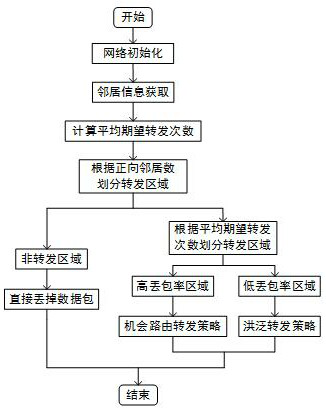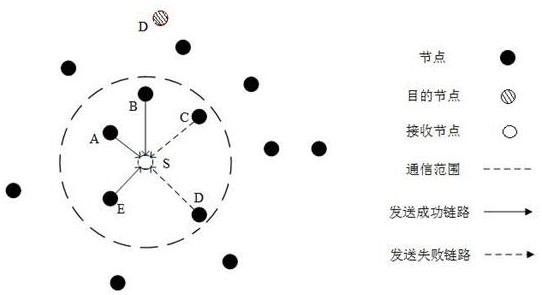Geographical routing protocol method applied to underwater acoustic sensor network
A technology of underwater acoustic sensors and geographic routing, applied in ultrasonic/acoustic/infrasonic transmission systems, transmission systems, advanced technologies, etc., can solve problems such as limited bandwidth, high end-to-end delay, expensive manufacturing and deployment costs, and achieve high Efficient routing, reducing the effect of high latency
- Summary
- Abstract
- Description
- Claims
- Application Information
AI Technical Summary
Problems solved by technology
Method used
Image
Examples
Embodiment Construction
[0030] 1) Acquisition of neighbor information
[0031] a) Broadcast request packet
[0032] Each node first needs to obtain its own neighbor information. The neighbor information is obtained by passing the request packet Req in the node. A timer value T is set in each node. req , but in order to avoid Req packet conflicts, we added a random jitter item. When the timing time is exhausted, the node generates a Req packet, adds its own ID and coordinates to the packet, broadcasts the Req packet, and then sets a new T req value.
[0033] b) Receive request packet
[0034] When the neighbor node m j received a message from m i When the Req package, it first gets the ID and coordinates in the package, then m j Calculate your own progress, the calculation progress formula is as follows:
[0035] ADV(m i ,m j ) = Dist(m j ,D)-Dist(m i ,D)
[0036] where ADV(m i ,m j ) means neighbor node m j Relative to the current forwarding node m i progress, Dist(m,S) represents the ...
PUM
 Login to View More
Login to View More Abstract
Description
Claims
Application Information
 Login to View More
Login to View More - R&D
- Intellectual Property
- Life Sciences
- Materials
- Tech Scout
- Unparalleled Data Quality
- Higher Quality Content
- 60% Fewer Hallucinations
Browse by: Latest US Patents, China's latest patents, Technical Efficacy Thesaurus, Application Domain, Technology Topic, Popular Technical Reports.
© 2025 PatSnap. All rights reserved.Legal|Privacy policy|Modern Slavery Act Transparency Statement|Sitemap|About US| Contact US: help@patsnap.com



